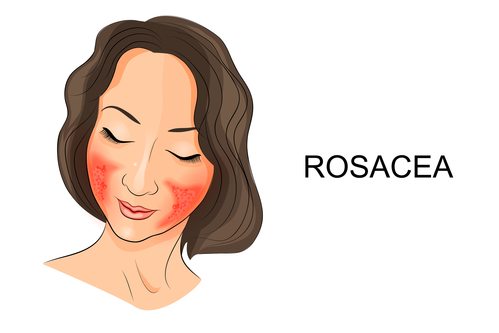What is rosacea? It’s more than a blush. Rosacea is a common skin condition that affects the face, causing persistent redness, visible blood vessels, and other signs of skin irritation. Although the condition can cause embarrassment, there are highly effective treatments that can help sufferers to face the world more comfortably.

What Is Rosacea?
Rosacea can occur in anyone. However, certain risk factors can increase the likelihood that someone will struggle with this skin condition. People have a higher risk of developing rosacea if they have fair skin, smoke, are female, are over the age of 30, or have a family history of the condition. Although it’s a common condition, rosacea is not completely understood. Doctors don’t know what causes it. While poor hygiene has been eliminated as a potential culprit, heredity and environmental factors are both on the list of suspects.
Symptoms of Rosacea
It is not uncommon for people with rosacea to see their symptoms wax and wane. When the condition flares, the following signs and symptoms can appear:
- Facial Redness: Rosacea tends to cause persistent redness and flushing across the nose and cheeks. Small blood vessels in these areas will often swell, which makes them more noticeable. Areas of the chin and forehead can also be involved, and the affected skin may feel tender and hot.
- Red Bumps: People suffering from rosacea often develop pimples that are reminiscent of acne. Sometimes these raised bumps contain pus as well.
- Eye Issues: Roughly half of people who deal with rosacea develop eye issues like dryness and irritation. The eyelids will often appear swollen and red. For some people with this condition, the eye problems occur before the skin symptoms.
- Nose Enlargement: Rhinophyma is the medical term used when the nose appears red, swollen, waxy, and bulbous. A problem more likely to impact men than women, this symptom of rosacea is rare but can appear when rosacea causes the skin on the nose to thicken.
Rosacea Triggers
While the root cause of rosacea remains unclear, doctors have noted strong links between various factors that irritate the skin or increase the blood flow to its surface, causing outbreaks of rosacea. Potential rosacea triggers that sufferers are often advised to approach cautiously include cosmetics, exercise, alcohol, hot drinks, and spicy foods. Temperature extremes, sunlight, wind, and emotional upheavals can also contribute to a flare. Even medications that dilate blood vessels, including some blood pressure medicines, can be problematic for people with rosacea.
Rosacea Treatments
There is no cure for rosacea, but a variety of treatments are available that can counteract the condition’s symptoms. Some patients do well with acne medications, antibiotics, or medications that reduce the skin’s redness. Laser therapy can be very effective in reducing enlarged blood vessels, which leads to a decrease in the amount of overall redness. In addition, many patients benefit immensely from the use of medical-grade skincare products like Epionce.
When exploring treatment options, patience is vital because it can take some time before patients see noticeable results. It can also be incredibly frustrating when rosacea that was under control flares. However, working with skincare professionals to find an effective treatment strategy can significantly reduce the appearance and discomfort of flare-ups.
_____
Do you experience persistent redness in your face? It might be rosacea. To learn more and explore treatments that might help, schedule a consultation with DermaHealth Laser & Skin Care Clinic if you live in southwest Missouri. We can treat the symptoms of rosacea using intense pulse light (IPL), KTP, or a genesis laser, which will decrease extra blood vessels and decrease the skin’s redness. Over time, these treatments can reduce rosacea flare-ups. To get started, please give us a call at 417-447-7777 or contact us online. We would be happy to help if you’re still wondering, “What is rosacea?”






